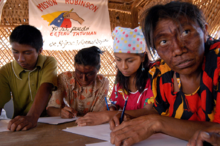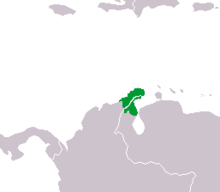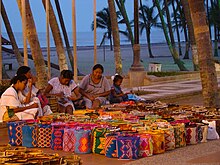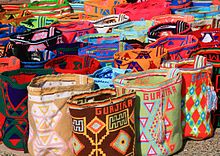Wayuu


The Wayuu (in Spanish Wayú ) or Guajiro are an indigenous people belonging to the Arawak in South America on the Guajira Peninsula , which belongs to Colombia and Venezuela .
The Wayuu language (also: Goajiro, Goaxiro or Wayuunaiki ) is one of the Arawak languages and is spoken by almost 700,000 people in Venezuela and Colombia. It is divided into different dialects, depending on where you live. All ages speak Wayuu, but many of the younger ones speak Spanish as well .
Settlement areas
Around 686,000 Wayuu people live in Venezuela and Colombia, mainly on their historically ancestral settlement area of the La Guajira peninsula , of which around 416,000 in Venezuela according to the 2015 census . There they make up the largest proportion of the country's indigenous population with 57% . Around 270,000 Wayuu live in Colombia, with around 20% of the country's indigenous population. In addition to the traditional main settlement area of the entire La Guajira peninsula, they also inhabit areas on the Sierra Nevada de Santa Marta and the Serrania del Perijá (Cabo de la Vela), called Jepira , a sacred site of great importance for the people who made the last trip the spirits are connected.
Due to the arid climate of the Guajira Peninsula, agriculture never contributed to the main part of the diet of the Wayuu - unlike the Taíno , which is closely related in language, rather fishing and hunting were important. Nowadays the Wayuu are mainly cattle breeders and are therefore economically integrated into the Colombian or Venezuelan market. Many Wayuu also work in the oil industry, for example in Maracaibo . The Wayuu still live in matrilineal extended families ( maternal lines ) today .
history
The Wayuu first lived in the area of today's Guayanas, from where they were expelled. When they arrived on the La Guajira peninsula, they changed their previous way of farming: For climatic reasons, the sole arable farming was supplemented by hunting, collecting and fishing. Another cultural change took place through the European conquest in the 16th century: The Italian Amerigo Vespucci was the first European to set foot on the east side of the Guajira peninsula in 1500. A few years later, Spanish sailors discovered pearl banks on the west side of the peninsula, at Cabo de La Vela. Slaves from the Caribbean were embarked for their economic development, but Wayuu were also enslaved as pearl divers. In addition to working as a pearl fisherman (both enslaved and free), the Wayuu's economy was changed once again when the Spaniards took over cattle farming. Cows, goats and horses were bred and trade with the Spanish conquerors, but also with other seafaring nations. The Dutch, French and English, who were enemies of the Spaniards, supplied tools, weapons and slaves - one reason for Wörrle why the Spaniards were never able to completely conquer the area. The Catholic missions, which were founded in the 17th century in Nazareth, Manaure and Maicao, among others, tried to exert influence. However, they did not get a great response: It is found that mostly only the ruins remained and the success of the largest mission school in Nazareth was based on the establishment of a vegetable farm.
Current threats
In January 2009, the United Nations Commissioner for Refugees (UNHCR) expressed concern about the increasing violence against the Wayuu and other indigenous communities in La Guajira in northeastern Colombia and urged Colombia to take the necessary measures to keep the indigenous people from violence and more violent Protect eviction. In connection with the increasing reorganization of illegal armed groups seeking control of the area rich in salt and important for drug trafficking to Venezuela and the Caribbean, the Wayuu are facing an increasing number of targeted murders, death threats, intimidation, extortion and subjected to forced displacement. According to official figures, the violence in the area has displaced more than 50,000 people. In the provincial reserve near Barrancas, Wayuu resist the largest coal company in Colombia, Cerrejón . The opencast mine has eaten up close to their settlement and is believed to be the cause of a number of environmental diseases in the community.
Settlement and social organization
The Wayuu live scattered across the peninsula in small settlements with up to 250 people. In a settlement there are five to six houses that together form a large house. The individual settlements are usually far away from each other in order to avoid mutual competition for cultivation and pasture areas. House roofs and walls used to be made of cactus fibers or clay, whereas today materials such as zinc and cement are increasingly being used to build houses.
The Wayuu are matrilineally organized, i. H. the lineage of female relatives is crucial and the name by which an individual Wayuu of a particular clan is identified comes from the mother. The individual clans are associated with an animal, which is a kind of ancestral animal of mythological origin. Today there are about 30 clans that live across the entire peninsula area. It is possible to get married between the different clans (exogamy) and members of different clans live in one settlement. Polygyny prevails in marriages : a man can marry several women, which is considered a sign of prosperity.
Great importance is attached to the sister's brother, who financially supports his sister's eldest son during his lifetime and after his death. B. when paying the bride price. On the other hand, the uncle is financially supported by his eldest niece, as he receives the bride money for her. The sister's brother is considered to be jointly responsible for the upbringing of his nieces and nephews and, if they have committed an offense, must answer for it instead of them.
Economy and craft
In the rainy season, cassava , watermelons, maize and various types of beans are grown on the arable land near the settlement , and fruits are also collected. Rotation and fallow land are unknown; instead, certain plants are burned, the ashes of which increase soil fertility. The main way of farming consists of keeping and breeding horses, goats, mules, cows, pigs, sheep and chickens. Meat is usually only consumed on special occasions; the cattle are more likely to be sold or used as a means of transport. The number of cattle gives information about the social status; the bride is paid for with the cattle or compensation is given in the event of a dispute. Markets in Uribia , Riohacha , Maicao and Paraguaipoa are visited to sell cattle ; Handcrafted products such as hammocks and woven bags are also offered there. The money earned is used to buy goods such as sugar, coffee, weapons, tools, etc. Although there is still fishing on the coasts and various species of game, birds and hares are hunted, these two branches of the economy play a subordinate role. Another source of income, especially during the dry season, is salt mining and trading, which began before the Spanish arrived. Since the end of the 1960s, dismantling has been assigned to the IFI (Instituto de Fomento Industrial, in German: Institute for Industrial Development), which uses mechanical mining methods and thus severely restricts the manual mining of the Wayuu. Other income opportunities can be found v. a. in the vicinity of or in cities, with men often working for construction companies or as truck drivers, while women are hired as domestic help, but mostly do not get a job as a skilled worker.
Handicrafts
The handicraft is very important in the Wayuu culture. The latter is expressed in myths, rites of passage and customs. A Wayuu bag is created using three techniques: weaving, knotting, and crochet, the crochet being relatively innovative. In the Wayuu culture, women crochet the bags as a socialization tool to memorize feminine virtues such as perfectionism and patience. Since the bags began to sell, middlemen have had them produced with double thread, which has resulted in a deterioration in the quality of the product: the production time is reduced from 3 weeks to 3 days, the patterns become imprecise and the stitches become loose. For bags made of two threads, it only takes 1.5 stitches to crochet an inch. Thus, those bags that are made with two meshes only require a third as much effort.
Stations of the life cycle
The birth of a child takes place in one's own home and is accompanied by the woman's mother or another close relative. In the first years of life, children are raised by their mother, then boys spend time with their maternal uncle, while girls are raised by a female relative. At the age of six, the children learn to do their first small tasks around the house or in the fields and livestock. In the transition from puberty to adulthood, girls go through a special rite of passage; in the case of boys, however, there is no party or the like Girls are separated from the rest of the family at the beginning of their first menstruation and have to spend several months (low social status) to even years (high social status) in a separate part of the house. During this time, female relatives teach them about tasks such as spinning and weaving, and contraceptive methods and erotic techniques are discussed. At the beginning of this period, the girl's hair is cut, and only family members, as well as potential husbands, are allowed to see the girl. After the end of the transition period, the girl is considered a woman of marriageable age; a celebration is held where she is allowed to put on her "adult clothes". Those willing to marry now send their father or uncle to the bride's family, who set the bride price, usually paid in cattle. If a woman neglects her domestic duties, the man can divorce her and the bride price will be paid back to him. If the man dies, all women pass to his brother; a woman can also buy her way out by paying her brother her bride price - more recent sources hardly provide any information about marriage and payment of the bride price.
Cosmology and necromancers
With the Wayuu, the medicine man or necromancer acts mainly as a healer. He is privileged to have contact with the helping spirit Wanülü, who provides information on diseases and their healing. However, Wanülü has other properties in everyday life, as can be seen below. While medicine people are of both sexes, there are more female healers. To become a necromancer, the initiate is taught by another necromancer and has to pay him / her for it with cattle. When the apprenticeship is over, the initiation takes place in a public celebration in which the helping spirit enters the body of the novice. While necromancers have better access to the spirit world than non-necromancers, they hardly influence everyday life spiritually. Various deities can be found within cosmology: Maleiwa is regarded as the main god, since he created the Wayuu. It is responsible for sending rain, which is a very important task under the prevailing climatic conditions. However, Mansen notes that he plays a negligible role in everyday life, as his name is rarely mentioned. On the other hand, the couple Pulowi, the woman, and Juya, the man, are found more often. Everyday phenomena are divided into the pair of opposites female-male in order to explain them. Rain is the product of the union of both, if it doesn't rain for a while, Juya visits his wives, who live all over the peninsula. Juya does not only stand for the mythical male figure, but also for the aforementioned phenomenon of rain and, more broadly, for the two rainy seasons. Likewise, Pulowi has several meanings that have to be differentiated depending on the context: Pulowi can also be places where disasters happen, in addition to the supernatural being. Pulowi and Juya form opposites such as light-dark, above-below, wild plants and arable plants or rigid and mobile. Wanülü and Yoluja are other supernatural beings that are closely related to the soul (A'in) of a person. Wanülü is responsible for illnesses and injuries, which then have to be treated by a necromancer. Often he is seen as a being who hunts people and injures them in the process. In one such case, A'in, also seen as the physical heart, was separated from the rest of the body. Death is to be understood as the permanent separation of the two. The Wayuu have the idea that the life cycle is not completed with death, instead a journey into the land of the souls of the dead (Jepira) takes place. The souls of the dead can communicate with the living, they then appear in form (Yoluja) or in dreams. An encounter with a Yoluja is considered bad as it is considered a connection to Jepira. The mythical place Jepira finds a real place reference at Cabo de la Vela, more precisely a single mountain peak that protrudes from the plain. When a Wayuu dies, the soul leaves its body and travels to Jepira; the body is buried. After reaching Jepira, the deceased becomes a Yoluja, a recently deceased person, with whom contact can still be made. After a few years, the body is exhumed and the bones are buried in the cemetery of the local matrilineal relatives. This is based on the idea that these relatives will meet again in the hereafter. After the second burial takes place, the yoluja turns into an anonymous wanülü, with whom contact can no longer be maintained. Perrin states that this is probably because "to nourish the hope that the local matrilineal ancestors will be preserved forever".
literature
- R. Daus: La Guajira: How a wild country is told (= Babylon Metropolis Studies ). Ursula Opitz Verlag, Berlin 2006.
- Maya Mazzoldi: Simbolismo del ritual de paso femenino entre los Wayuu de la alta Guajira. In: Maguaré. No. 18, 2004, pp. 241-268 (Spanish).
- B. Wörrle: From cooking to damaging magic: The salt among the Indians and Mestizos of Latin America (= Munich American Studies Articles. Volume 3). Academic publishing house, Munich 1996.
- RA Mansen: Dispute Negotiations among the Guajiro of Colombia and Venezuela: Dynamics of Compensation and Status. University Microfilms International, Michigan 1988 (English).
- M. Perrin: The Way of the Dead Indians. Guajiro Myths and Symbols (= Texas Press Sourcebooks in Anthropology. Volume 13). University of Texas Press, Austin 1987 (English).
- A. Rivera Gutierrez: Material Life and Social Metaphor: Change and Local Models among the Wayuu Indians of Colombia and Venezuela. University of Minnesota, 1986 (English).
- Maria-Barbara Watson-Franke: Seclusion Huts and Social Balance in Guajiro Society. In: Anthropos. Volume 77, No. 3/4, 1982, pp. 449-460 (English).
- Erich Wustmann : On the way to see dwarf Indians in Colombia. Neumann, Radebeul 1973, pp. 13–72 (travel description: stay with the Wayuu / Guajiro).
- J. Armstrong, A. Métraux: The Goajiro. In: J. Steward (Ed.): Handbook of South American Indians (= Smithsonian Institution. Bureau of American Ethnology. Bulletin 143). Volume 4: The Circum-Caribbean Tribes. United States Government Printing Office, Washington 1948 (English).
Movies
Documentaries:
- 2013: Priscilla Padilla: La Eterna Noche de las Doce Lunas. Colombia 2013 (87 minutes, original Spanish version with subtitles , award-winning; girl lives secluded in a hut for a year after the onset of menstruation , only women are allowed to visit).
- 2005: Guillermo Ojeda Jayariyu, Leiqui Uriana Henriquez: El sistema normativo de los wayuus, aplicado por el pütchipü'üi ("palabrero") on YouTube. Colombia 2005 (10 minutes, Spanish; El pütchipü'üi: “the mediator”).
Feature films:
- 2018: Cristina Gallego, Ciro Guerra : Birds of Passage - The Green Gold of the Wayuu . Colombia 2018 ( Pájaros de verano. Original with subtitles; German trailer on YouTube).
Web links
- UNESCO : Wayuu normative system, applied by the Pütchipü'üi (palabrero). , 2009/2010, accessed on December 29, 2018 (English).
- Kun Li: Youth radio keeps indigenous culture alive in Venezuela. UNICEF radio culture program, January 15, 2007, accessed December 29, 2018
Individual evidence
- ↑ Ethnologue -Lexikon: Wayuu - a language of Colombia. 2018, accessed on December 29, 2018.
- ↑ Long Which lexicon of Ingmar Eschli: Goaxiro. Retrieved on December 29, 2018 (including information about the people).
- ↑ Primeros Resultados Censo Nacional 2011: Población Indígena de Venezuela. National Institute of Statistics, January 2013, accessed December 28, 2018.
- ↑ WAYÚU Gente de arena, sol y viento. Ministry of Culture of Colombia, 2005 census, accessed December 28, 2018.
- ↑ a b Wörrle 1996, p. 63.
- ↑ Daus 2006, p. 12.
- ↑ Daus 2006, p. 14f.
- ↑ Mansen 1988, p. 95.
- ↑ Daus 2006, p. 16ff.
- ↑ Perrin 1987, p. XI.
- ↑ Daus 2006, p. 17f.
- ↑ ACNUR pide que a Colombia Proteja a los que son indígenas Víctimas de Ataques. In: El Tiempo. January 27, 2009, accessed December 16, 2018 (Spanish).
- ↑ barrancas-laguajira.gov.co
- ↑ Colombia: "The coal is stained with blood". In: The time. April 18, 2013, accessed December 16, 2018 .
- ↑ a b c d e Perrin 1987, Chapter 14.
- ^ Armstrong, Métraux 1948, p. 371.
- ↑ a b c d e f g h i Wayúu. In: Ethnias de Colombia. Fundación Hemera, 2003, archived from the original on February 21, 2009 ; Retrieved December 16, 2018 (Spanish).
- ↑ Mansen 1988, pp. 106f.
- ↑ a b Armstrong, Métraux 1948, p. 374.
- ↑ Mansen 1988, p. 109f.
- ↑ a b c Perrin 1987, Chapter 13.
- ↑ Mansen 1988, pp. 105f.
- ↑ Mansen 1988, p. 87.
- ↑ The Wayuu Bag Market: Art versus Commerce. In: Mama Tierra Association. February 2, 2016, accessed December 16, 2018 .
- ↑ Mazzoldi 2004, pp. 241-268.
- ^ Armstrong, Métraux 1948, p. 378.
- ↑ Armstrong, Métraux 1948, pp. 378f.
- ↑ a b Perrin 1987, pp. 82-83.
- ↑ Mansen 1988, p. 148.
- ↑ a b Armstrong, Métraux 1948, p. 382.
- ↑ Perrin 1987, p. 75.
- ↑ Mansen 1988, p. 135.
- ↑ Rivera Gutierrez in: Mansen 1988, p. 136.
- ↑ Perrin 1987, p. 78f.
- ↑ Perrin 1987, pp. 80f.
- ↑ Perrin 1987, p. 95.
- ↑ Mansen 1988, pp. 138ff.
- ↑ Perrin 1987, p. 97.
- ↑ Perrin 1987, pp. 110f.
- ↑ Mansen 1988, p. 138.
- ↑ Perrin 1987, p. 112.
- ↑ IMDb entry . Film review by Maria Wiesner: Sweet drug capitalism. In: Kino-zeit.de. Undated (2018), accessed December 16, 2018.



